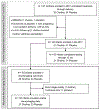Maternal choline supplementation mitigates alcohol exposure effects on neonatal brain volumes
- PMID: 34342017
- PMCID: PMC8526390
- DOI: 10.1111/acer.14672
Maternal choline supplementation mitigates alcohol exposure effects on neonatal brain volumes
Abstract
Background: Prenatal alcohol exposure (PAE) is associated with smaller regional and global brain volumes. In rats, gestational choline supplementation mitigates adverse developmental effects of ethanol exposure. Our recent randomized, double-blind, placebo-controlled maternal choline supplementation trial showed improved somatic and functional outcomes in infants at 6.5 and 12 months postpartum. Here, we examined whether maternal choline supplementation protected the newborn brain from PAE-related volume reductions and, if so, whether these volume changes were associated with improved infant recognition memory.
Methods: Fifty-two infants born to heavy-drinking women who had participated in a choline supplementation trial during pregnancy underwent structural magnetic resonance imaging with a multi-echo FLASH protocol on a 3T Siemens Allegra MRI (median age = 2.8 weeks postpartum). Subcortical regions were manually segmented. Recognition memory was assessed at 12 months on the Fagan Test of Infant Intelligence (FTII). We examined the effects of choline on regional brain volumes, whether choline-related volume increases were associated with higher FTII scores, and the degree to which the regional volume increases mediated the effects of choline on the FTII.
Results: Usable MRI data were acquired in 50 infants (choline: n = 27; placebo: n = 23). Normalized volumes were larger in six of 12 regions in the choline than placebo arm (t ≥ 2.05, p ≤ 0.05) and were correlated with the degree of maternal choline adherence (β ≥ 0.28, p ≤ 0.04). Larger right putamen and corpus callosum were related to higher FTII scores (r = 0.36, p = 0.02) with a trend toward partial mediation of the choline effect on recognition memory.
Conclusions: High-dose choline supplementation during pregnancy mitigated PAE-related regional volume reductions, with larger volumes associated with improved 12-month recognition memory. These results provide the first evidence that choline may be neuroprotective against PAE-related brain structural deficits in humans.
Keywords: Fagan Test of Infant Intelligence; brain volumes; magnetic resonance imaging; maternal choline supplementation; neonates; prenatal alcohol exposure.
© 2021 Research Society on Alcoholism.
Conflict of interest statement
Figures



Comment in
-
Choline supplementation as an intervention for fetal alcohol spectrum disorders: A commentary.Alcohol Clin Exp Res. 2021 Dec;45(12):2465-2467. doi: 10.1111/acer.14732. Epub 2021 Nov 18. Alcohol Clin Exp Res. 2021. PMID: 34716714 Free PMC article. No abstract available.
References
-
- Archibald SL, Fennema-Notestine C, Gamst A, Riley EP, Mattson SN, Jernigan TL (2001) Brain dysmorphology in individuals with severe prenatal alcohol exposure. Dev Med Child Neurol 43:148–54. - PubMed
-
- Burd L, Klug MG, Martsolf JT, Kerbeshian J (2003) Fetal alcohol syndrome: neuropsychiatric phenomics. Neurotoxicol Teratol 25:697–705. - PubMed
-
- Clogg CC (1995) Latent Class Models In: Handbook of Statistical Modeling for the Social and Behavioral Sciences , pp 311–359. Boston, MA, Springer US.
Publication types
MeSH terms
Substances
Grants and funding
LinkOut - more resources
Full Text Sources
Medical

